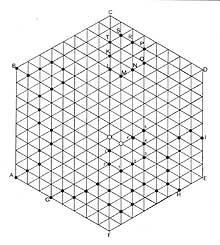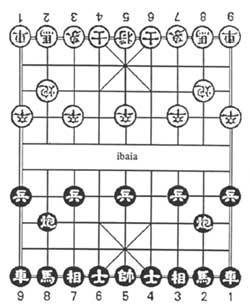Damero Damero
1989/03/01 Angulo, Patxi Iturria: Elhuyar aldizkaria
We will first analyze some of the features of the game of ladies and then we will present you some games.
In the game of the ladies intervene two players, with a tile of 12 in two different colors (black and white). The ladies' table is placed leaving a white square in the right corner of the first row (as in chess). (We call first row, player, to the row closest to one. In the images of this article, the bottom, that is, the closest to the reader). The chips of both players are placed in black squares in the first three rows. The tiles can be moved diagonally a square forward. This means that all tiles (of the two players) only move on black squares. Therefore, the white squares are free, where you can play another game of ladies. That is, in the same ladies table four players can participate simultaneously in two matches, one in the white squares and one in the black squares.
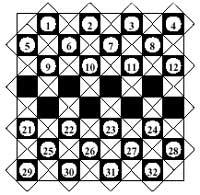
This double match would probably be complicated, so we could go another way. If only black squares are used, what do we want white? Therefore remove the white squares. For this purpose, on the black squares we will represent other larger ones (figure 1). In the table so obtained (with teeth) you can develop games that only need black boxes to play, adapting their rules to the new situation.
Through this transformation, the diagonals of the ladies' table have become rows or columns and rows and columns in diagonals. Now, for example, the white tiles would be placed in numbered grids from 1 to 12. Black, however, in those of 21 to 32. And in this new table the tiles should move forward both by rows and by columns. Try to play in this new table (with teeth) (but remove the normal damper below).
In the ladies table you can develop many games. We bring you here “Xama” or “Daxe” and “Chinese ladies”.
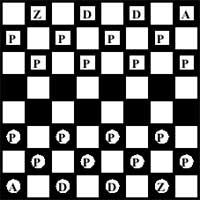
Game that we could call “Xama” or “Dake”, Solomon W. It was invented by Golomb and the chess games and ladies are mixed. As in the ladies, it is played on 32 black squares (so this game can also be played on the decked board). Each player must place 12 pieces in the first three rows. The location of the pieces can be seen in figure 2. The eight pawns (P) must move as in the ladies' game. The same applies to the two ladies (D). On the contrary, the profile (A) must move as in chess. With the Chess Horse (Z) a problem arises. And it is that when the horse moves in chess changes the color of its quadruple (that is, if it is in the black box, when moving it we will have obligatory in the white box), but as we have said before we should only play in the black squares.
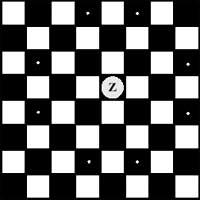
To avoid this problem Golombe invented a piece of money from horses. This piece, when we move it, will form an L, but instead of forming an L of 2x1, another of 3x1. Thus it will always circulate in black squares (figure 3). This money, when necessary, can pass over other pieces as in chess. The pawns and the ladies to catch the opponent's pieces are thrown like in the damper passing over the pieces. Parades and horses, as in chess, filling the place of the trapped piece.
The ladies and the pawns have to eat obligatorily, (the pawns have to eat like the ladies and not like chess), while when they eat parades and horses they cannot jump. If there is more than one option to eat, you can choose any possibility, whether from lady or pawn or bishop or horse. When only these last two have a choice to eat, it will not be necessary to eat. The pawns that reach the last line can be exchanged with any other piece, that is, with lady, bishop or horse. Players will move the pieces in turns. The aim of the game is to eat or catch the ladies on the contrary. The first one to stay without ladies will lose it. Therefore, when you have to redeem the pawn, you have to choose the new piece well. While the ladies serve for defense, they will serve to attack parades and horses.
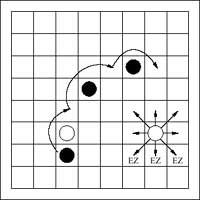
The other game is the so-called “Chinese ladies”. Each player has eight tiles. These should be placed in the first row, both in black and white. The aim of the game is to place the eight tiles in the front row of the opposite. The movement of the tiles can be carried out as can be seen in figure 4, that is, from the eight squares that surround a square to the three grids backwards and to the other five, but only one grid in each direction (that is, horizontal, diagonal or forward). If next to a tab A (in any direction) there is another tab B (of the same color or of another type), the tab A can pass over the tab B, advancing two squares, but does not eat the tab B (See figure 4). Somehow this tab B helps to advance further. The jump can be double, triple and “alpargata” (as in the ladies), but in each jump can only pass over a tile.
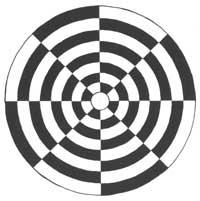
Finally, we present the circular table you see below. It is no more than a table of ladies. The chips of a player are located around the center. The other, on the other hand, with respect to the external limit. As can be easily seen, in this table there are no edges and all are diagonal main. I have never played in such things. Somewhere I read something about the circular table of chess and immediately came to my head the idea of circular damero. As soon as I thought, I did what you see here. Then I started to think what I could do about the rules and decided that to start I had to play with the rules of the game of ladies. Then, perhaps, if we have to change some standard, we invent something. For the moment, let's try to play the ladies in this circular table.

Gai honi buruzko eduki gehiago
Elhuyarrek garatutako teknologia




